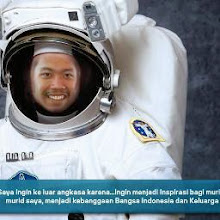Central for Research and Development for Winning
Nobel Prize in Physics at IndonesiaNobel Fisika Indonesia
"In any solid metal, there are one or two electrons per atom that are free to move from atom to atom. This is sometimes collectively referred to as a "sea of electrons". Their velocities follow a statistical distribution, rather than being uniform, and occasionally an electron will have enough velocity to exit the metal without being pulled back in. The minimum amount of energy needed for an electron to leave a surface is called the work function. The work function is characteristic of the material and for most metals is on the order of several electronvolts. Thermionic currents can be increased by decreasing the work function. This often-desired goal can be achieved by applying various oxide coatings to the wire."
~Richardson's Law~

The Nobel Prize in Physics 1928
"for his work on the thermionic phenomenon and especially for the discovery of the law named after him"
 |
| United Kingdom |
| London University London, United Kingdom |
| b. 1879 d. 1959 |
Photos: Copyright © The Nobel Foundation
Nobel Lecture
Nobel Lecture, December 12, 1929
Thermionic Phenomena and the Laws which Govern Them
From Nobel Lectures, Physics 1922-1941, Elsevier Publishing Company, Amsterdam, 1965
In order to read the text you need Acrobat Reader.
Biography
Richardson was born in Dewsbury, Yorkshire, England, the only son of Joshua Henry and Charlotte Maria Richardson. He was educated at Batley Grammar School and Trinity College, Cambridge, where he gained First Class Honours in Natural Sciences.[2]
After graduating in 1900, he began researching the emission of electricity from hot bodies at theCavendish Laboratory in Cambridge, and in 1902 he was made a fellow at Trinity. In 1901, he demonstrated that the current from a heated wire seemed to depend exponentially on the temperature of the wire with a mathematical form similar to the Arrhenius equation. This became known as Richardson's law: "If then the negative radiation is due to the corpuscles coming out of the metal, the saturation current s should obey the law  ."[3]
."[3]
 ."[3]
."[3]Richardson was professor at Princeton Universityfrom 1906 to 1913, and returned to the UK in 1914 to become Wheatstone Professor of Physics at King's College London, where he was later made director of research. He retired in 1944, and died in 1959.
He also researched the photoelectric effect, the gyromagnetic effect, the emission of electrons by chemical reactions, soft X-rays, and the spectrum of hydrogen.
Richardson married Lilian Wilson, sister of his Cavendish colleague Harold Wilson, in 1906, and had two sons and a daughter. Richardson's own sister married the American physicist (and 1937 Nobel laureate) Clinton Davisson, who was Richardson's PhD student at Princeton. After Lilian's death in 1945, he was remarried in 1948 to Henriette Rupp, a physicist.
Honours
Richardson became a Fellow of the Royal Society in 1913, and was awarded its Hughes Medal in 1920. He was awarded the Nobel Prize in Physics in 1928, "for his work on the thermionic phenomenon and especially for the discovery of the law named after him".[4] He was knighted in 1939.
References
- ^ Nobel Foundation (1928). "Owen Willans Richardson: The Nobel Prize in Physics 1928". Les Prix Nobel. Retrieved 2007-09-17.
- ^ Richardson, Owen Willans in Venn, J. & J. A., Alumni Cantabrigienses, Cambridge University Press, 10 vols, 1922–1958.
- ^ Proceedings of the Cambridge Philosopical Society, quoted in
- ^ Nobel prize citation, Nobel foundation website
Sumber:
1. Wikipedia
2. Nobel Prize Org.
Ucapan Terima Kasih:
Ucapan Terima Kasih:
1. DEPDIKNAS Republik Indonesia
2. Kementrian Riset dan Teknologi Indonesia
3. Lembaga Ilmu Pengetahuan Indonesia (LIPI)
4. Akademi Ilmu Pengetahuan Indonesia
5. Tim Olimpiade Fisika Indonesia
Disusun Ulang Oleh:
Arip Nurahman
Pendidikan Fisika, FPMIPA, Universitas Pendidikan Indonesia
&
Follower Open Course Ware at MIT-Harvard University, USA.
























